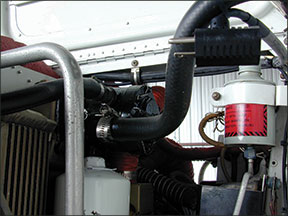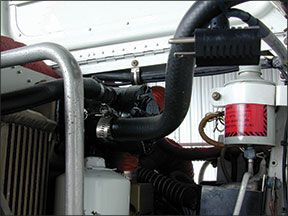Perhaps the most expensive aspect of aircraft ownership is maintenance. Owners of even relatively simple airplanes—fixed gear and a fixed-pitch prop, for example—can save real money by learning and performing basic work. The FARs allow pilots of aircraft used in non-commercial operations (and even some flying for hire) to perform specific tasks on their own, without the need for a certificated technician.

288
But before you dive into something simple like an oil change, there are a few things you’ll need to learn and a few tools you may want to acquire. Even if you know your way around a toolbox, however, you may want to work with a mechanic at first. And while the FARs concerning so-called preventive maintenance are a bit outdated and vague, that can be a good thing, too. But before you do anything in the way of preventive maintenance on your aircraft, you need to understand the rules and the resources necessary for success. A little training won’t hurt anything, either.
Regs and guidance
The sidebar on the opposite page excerpts the relevant FARs and the list of preventive maintenance (PM) items a mere pilot can legally perform. Some of them are quite specific; others include loopholes large enough to get you into major trouble. Understanding what’s allowed as PM, what’s not and what falls into a gray area is the first step. For example, engine oil changes are traditionally considered one of the allowed tasks, but the FAR doesn’t specifically state changing the oil is allowed, only the filter. Similarly, an engine’s air filter isn’t on the list, but replacing a side window is?
The FARs, of course, aren’t the only pertinent guidance on PM—there’s an FAA Advisory Circular, too. Advisory Circular AC 43-12A, Preventive Maintenance, is available on the agency’s Web site. Believe it or not, it actually includes more legalese than the FARs, and stresses the need for a logbook entry documenting the work performed and returning the aircraft to service. It also cautions about how the tasks are to be performed.
For example, the AC states those performing PM must “[u]se methods, techniques, and practices acceptable to the Administrator. These are normally set forth in the manufacturer’s maintenance manuals; however, some may be found in ACs published by the FAA.” In other words, you’ll need some documentation and reference materials. These items can include the airframe and engine manufacturers’ approved maintenance manual, parts catalogs, service bulletins, etc. The owner’s manual with tire pressure data, an airframe lubrication chart and an engine-oil specification won’t cut it.
Additionally, the AC cautions some tasks may be simple but “because of differences in aircraft, a function may be preventive maintenance on one aircraft and not on another.” The AC also suggests some soul-searching: “Owners/operators should ensure that the individual performing the preventive maintenance understands the manufacturer’s instructions, and the function is within the individual’s capability.”
Most of the tasks should be a piece of cake for someone who regularly wrenches on a car, truck, boat, motorcycle or similar machine. But performing PM on an aircraft differs from, say, what the average backyard mechanic has done in many ways. One way is the documentation, tools and supplies that may be necessary.
References and Tools
In addition to the maintenance and parts manuals highlighted above, the manner in which PM tasks are performed also is of interest. Once again, the FAA has this covered, in the form of another Advisory Circular, AC 43-13-1B, Acceptable Methods, Techniques, and Practices. This AC is large but contains detailed descriptions and data on inspecting and repairing civil aircraft when no manufacturer-approved repair or maintenance instructions exist. It’s also available on the FAA’s Web site.
Our first thought when contemplating a PM task or advising other owner/pilots how to do things on their bird is to do no harm. This means having and using the correct tools when performing PM. Rounding off a stubborn bolt, or stripping the head of a Phillips screw constitutes doing harm in our book, as does dropping a tool or part under the floorboards or into the tailcone, where it’ll be difficult to retrieve and could jam in the control system.

288
With that in mind, the first tool you should consider acquiring for your PM work is a decent pair of safety-wire pliers. These are specially designed to cut and twist the safety wire securing things like oil filters and other components. They’re available from the usual suspects but also at tool retailers and even discounters like Harbor Freight (aka “Horrible Fright”).
Another useful tool is a torque wrench, a high-tech ratchet designed to alert the user when the fastener it’s turning has reached a pre-set limit. They’re also available from tool suppliers and come in many different sizes and qualities. Regardless of what torque wrench you obtain, you’ll need sockets to match. You should consider a set offering standard and deep SAE sockets ranging from ¼ inch to at least a full inch. If your aircraft was designed and/or manufactured overseas, you also may need a set of metric sockets. Hand wrenches covering the same range of sizes also are a must.
When it comes to screwdrivers, the ubiquitous #2 Phillips will come in very handy. You might consider a good-quality ratcheting screwdriver, which can make removing inspection covers less tedious. Under no circumstances would we advocate using a powered screwdriver on an aircraft: It’s an excellent tool for over-torquing and stripping screws.
The need for and number of special, aircraft-only tools required depends on how adventurous or ambitious you are. For example, if you’re going to repaint all or part of your aircraft, you may want to consider building a paint booth. If you’re going to be changing its tires and lubing wheel bearings, you’ll need adequate jacks, which can get pricey. Whatever work you decide to perform under the PM rules, ensure you have the right tools.
Supplies
To go with your spiffy new safety-wire pliers, you’ll need some safety wire. A pound of it goes for around $10 at your FBO, at airshows and fly-ins, or from your favorite pilot-supply house. Get the 0.032-inch diameter size, which should be made of stainless steel.
What other supplies you’ll need is, again, dictated by the work you plan to perform. For instance, oil changes require fresh oil and filters. A tube of Dow Corning’s DC-4, a grease-like silicone material, is recommended by some filter manufacturers for coating—sparingly!—the oil filter gasket prior to reassembly. The product also can be used to create a moisture-proof seal for ignition and electrical systems.
For cleaning and reinstalling spark plugs, a tray like the one pictured in the bottom image on page 9 can come in handy, along with a socket compatible with your torque wrench and the parts used on your engine. Many spark plug manufacturers recommend applying an anti-seize compound to the threads before reinstallation, and the material also can be used in other applications.
Lubricating the airframe—e.g., retractable landing gear—requires the appropriate grease and a way to apply it, usually a grease gun. One trick is that the lubricants specified when your older aircraft was manufactured may no longer be available, or the applicable standards may have changed. In such instances, the manufacturer usually has issued a service bulletin listing acceptable alternatives. The good news is modern lubricants usually are far superior to what they supercede.
Training
Now that you’ve got some tools and some supplies, you’ll be tempted to dive right in and, say, overhaul the landing gear. Not so fast, please. Ideally, you’ll get a friendly mechanic to spend some time at your hangar—or his—to show you a few things about working on aircraft. How to actually safety-wire something, for example (although AC 43-13-1B includes a thorough discussion of the techniques involved).
Ask him or her to walk you through an oil change, or spark-plug cleaning and rotation. Repacking wheel bearings, which will require jacking the airplane, is another task with which you might not be familiar. The good news is there’s lot of documentation available from manufacturers, including those who offer aftermarket parts like tires and brakes. Also ask your mechanic to go through the documentation necessary to properly record in the aircraft’s logbooks the work you’ve performed.
The sidebar on page 9 discusses the various PM tasks the FAA allows you, as a pilot, to perform on your aircraft. Woven throughout the regulations and guidance is the concept that PM does not include complex tasks or disassembly. What may at first seem a daunting and complex project—refurbishing your interior, for example—is easily managed if the various tasks are broken down into onesies and twosies. Also, having the correct tools can transform something complex into something simple.
Performing preventive maintenance on your own aircraft isn’t for the faint of heart, but if you like to tinker or are mechanically inclined, it can be a natural extension of your ownership experience. You’ll likely save time and money in the process, while learning about your aircraft. The end result can enhance its safety, utility and efficiency.




